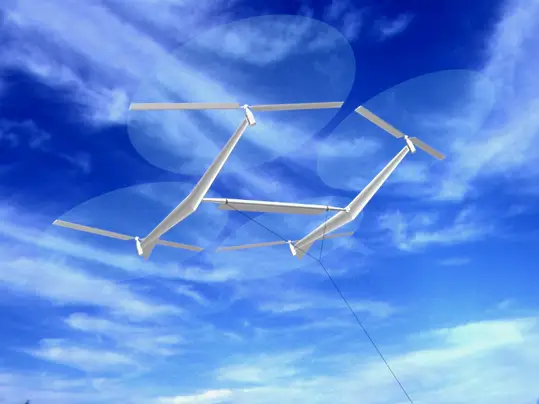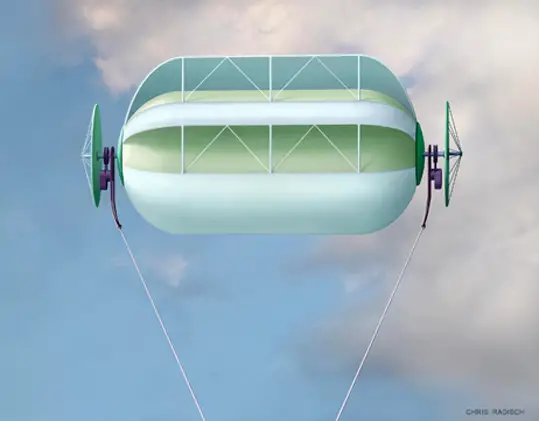A Flying Energy Generator (FEG) is a tethered device, which taps into the energy in high altitude winds, miles above the earth’s surface. Some argue that if FEGs are successfully developed they could supply most of the worlds stationary energy needs.
David Shepard is the president of renewable energy company Sky WindPower, in California and he thinks if we were able to tap 1% of the wind energy at high altitude, it would be enough to supply all the world’s energy needs. The company claims only relatively small rotors are necessary to generate megawatts of power, if the devices capture the high velocity high altitude winds. They suggest that the Flying Energy Generators may be expected to be in the ten to forty megawatt range instead of the highest current tower mounted turbine capacities of about five megawatts.
Instead of two rotors, the FEGs under development will use four rotors in a square arrangement, or more in bigger arrangements. For example eight, each rated at 2.5 Megawatts, for a total of 20MW. Apparently, tether strength to weight ratios actually improve as sizes scale up, and guidance control weight goes up less than proportionately with size. In other words, within reasonable limits, such as into the tens of megawatts range, efficiency may be expected to improve with scale.
Sky WindPower plans to demonstrate the FEG pictured below, which was developed by Professor Roberts, at an altitude of 15,000 feet and above.

The Magenn Power’s MARS is another wind power device that operates differently to the FEG above. The Magenn company say the distinct advantages of the MARS over existing conventional wind turbines is the capacity of the devices to be deployed globally, with lower costs, better operational performance, and greater environmental advantages.
MARS is a lighter-than-air tethered wind turbine that rotates about a horizontal axis in response to wind, generating electrical energy. This electrical energy is transferred down the 1000-foot tether for immediate use, or to a set of batteries for later use, or to the power grid. Helium sustains MARS and allows it to ascend to a higher altitude than traditional wind turbines. MARS captures the energy available in the 600 to 1000-foot low level and nocturnal jet streams that exist almost everywhere. MARS rotation also generates the “Magnus effect” which provides additional lift, keeps the MARS stabilized, and positions it within a very controlled and restricted location to adhere transport guidelines.

